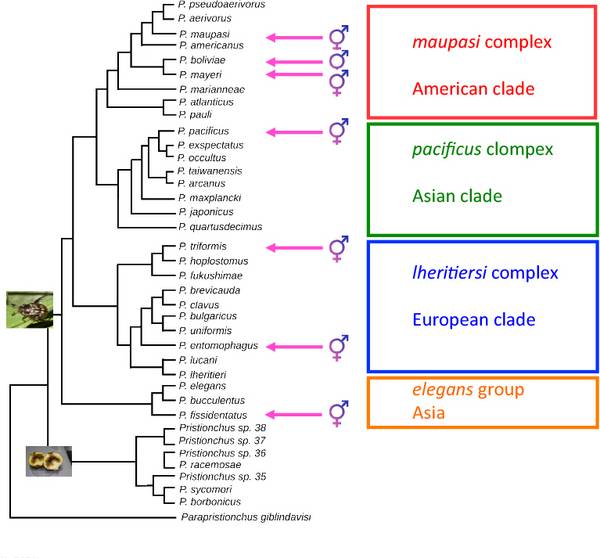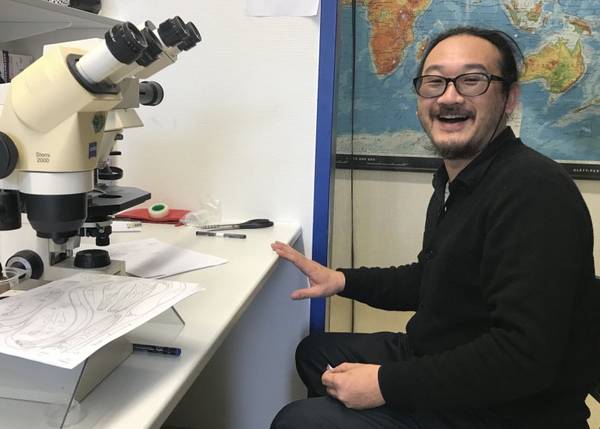
Our work since 2004 revealed that nematodes of the genus Pristionchus live in close association with certain beetles. We carried out numerous field trips to locations in Western Europe, the Eastern United States, South-Africa and Japan. From 25,000 beetles, we established more than 8,000 Pristionchus isolates, which fall into 39 species, most of which are cryptic. That is, they can only be distinguished by molecular sequence analysis and mating experiments (Herrmann et al., 2006a, 2006b, 2007). These results indicate that Pristionchus provides a system, in which cryptic biodiversity and species interactions can be studied in great detail.
We have provided a robust phylogeny of all available Pristionchus species based on a set of 27 ribosomal protein genes encompassing a total of 10,971 bp. The phylogenetic tree provides evidence for North American and European clades, while Asian species have a basal position. It also indicates putative invasion events. Of the 30 Pristionchus species, 23 are gonochoristic and seven are hermaphroditic. The phylogeny indicates that all hermaphroditic species have arisen independently within the genus Pristionchus.
More recent sampling revealed the existence of a second branch of Pristionchus that lives in association with figs and fig trees. These species show an extraordinary diversification in the number and quality of mouth-forms (Susoy et al., 2016).
A robust phylogenetic framework of the genus Pristionchus is essential for the evolutionary interpretations of differences in developmental and ecological patterns. An additional major implication of our studies is the use of Pristionchus for nematode biodiversity assessments. While some species are represented by more than 100 isolates, others were found less than five times. Such patterns were observed on all continents and in all phylogenetic clades indicating that species asymmetry is a widespread phenomenon that can only be investigated by molecular tools.

The taxonomic work is performed in collaboration with Dr. Natsumi Kanzaki from the Kansai Research Center, Kyoto, Japan
Yoshida, K., Rödelsperger, C., Röseler, W., Riebesell, M., Sun, S., Kikuchi, T. & Sommer, R. J. (2023): Chromosome fusions repatterned recombination rate and facilitated reproductive isolation during nematode speciation. Nature Ecology & Evolution, 7, 424-439.
Kanzaki, N., Herrmann, M., Weiler, C., Röseler, W., Theska, T., Berger, J., Rödelsperger, C. & Sommer, R.J. (2021): Nine new Pristionchus (Nematoda: Diplogastridae) species from China. Zootaxa, 4943, 1-66.
Rödelsperger, C., Röseler, W., Prabh, N., Yoshida, K., Weiler, C., Herrmann, M. & Sommer, R. J. (2018): Phylotransciptomics of Pristionchus nematodes reveals parallel gene loss in six hermaphroditic lineages. Current Biology, 28, 3123-3127.
Kanzaki, N., Herrmann, M., Yoshida, K., Weiler, C., Rödelsperger, C. & Sommer, R. J. (2018): Samplings of Millipedes in Japan and Scarab Beetles in Hongkong result in five new species of Pristionchus (Nematoda: Diplogastridae). J. of Nematology, 50, 587-610.
Herrmann, M., Kanzaki, N., Weiler, C., Yoshia, K., Rödelsperger, C. & Sommer, R. J. (2018): Two new species of Pristionchus (Nematoda: Diplogastridae) include the gonochoristic sister species of P. fissidentatus. J. of Nematology, 51, 1-14, doi: 10.21307/jofnem-2019-024
Yoshida, K., Herrmann, M., Kanzaki, N., Weiler, C., Rödelsperger, C. & Sommer, R. J. (2018): Two new species of Pristionchus (Nematoda: Diplogastridae) from Taiwan and the definition of the pacificus species-complex sensu stricto. J. of Nematology, 50, 355-368. doi:10.21307/jofnem-2018-015
Herrmann, M., Weiler, C., Rödelsperger, C., Kanzaki, N. & Sommer R.J. (2016): Two new Pristionchus species (Nematoda: Diplogastridae) from Taiwan are part of a species-cluster representing the closest known relatives of the Model Organism P. pacificus. Zoological Studies, 55: 48.
Susoy, V., Herrmann, M., Kanzaki, N., Kruger, M., Nguyen, C. N., Rödelsperger, C., Röseler, W., Weiler, C., Giblin-Davis, R. M., Ragsdale, E. J. & Sommer, R. J. (2016): Large-scale diversification without genetic isolation in nematode symbionts of figs. Science Advance, 2: e1501031.
Susoy, V., Ragsdale, E. J., Kanzaki, N. & Sommer, R. J. (2015): Rapid diversification associated with a macroevolutionary pulse of developmental plasticity. eLIFE, 4: e05463.
Featured in: Nijhout, H. F. (2015): To plasticity and back again. eLIFE, 4: e06995.
Herrmann, M., Neuner, J., Vötsch, M., Wörner, J., Kanzaki, N. & Sommer, R. J. (2015): Pristionchus scratchpads - an online platform for taxonomy, systematics and phylogeny. Zootaxa, 3949, 597-600.
Ragsdale, E. J., Kanzaki, N. & Sommer, R. J. (2014): Levipalatum texanum n. gen., n. sp. (Nematoda: Diplogastridae) an androdioecious species from the southeastern United States. Nematology, 16, 695-709.
Kanzaki, N., Ragsdale, E., Herrmann, M., & Sommer, R. J. (2014): Two new and two recharacterized species resulting froma radiation of Pristionchus (Nematoda: Diplogastridae) in Europe. J. of Nematology, 46, 60-74.
Kanzaki, N., Ragsdale, E., Susoy, V., & Sommer, R. J. (2014): Leptojacobus dorci n. gen., n. sp. (Nematoda: Diplogastridae), an associate of Dorcus stag beetles (Coleoptera: Lucanidae). J. of Nematology, 46, 50-59.
Herrmann, M., Ragsdale, E. J., Kanzaki, N., & Sommer, R. J. (2013): Sudhausia aristotokia n. gen., n. sp. and S. crassa n. gen., n. sp. (Nematoda: Diplogastridae): viviparous new species with precocious gonad development. Nematology, 15, 1001-1020.
Kanzaki, N., Ragsdale, E. J., Herrmann, M., Susoy, V., & Sommer, R. J. (2013): Two androdioecious and one dioecious new species of Pristionchus (Nematoda: Diplogastridae): new reference points for the evolution of reproductive mode. Journal of Nematology, 45, 172-194.
Ragsdale, E. J., Kanzaki, N., Roeseler, W., Herrmann, M. & Sommer, R. J. (2013): Three new species of Pristionchus (Nematoda: Diplogastridae) show morphological divergence through evolutionary intermediates of a novel feeding polymorphism. Zool. J. Linn. Soc., 168, 671-698.
Kanzaki, N., Ragsdale, E. J., Herrmann, M., Roeseler, W. & Sommer, R. J. (2013): Two new species of Pristionchus (Nematoda: Diplogastridae) support the biogeographic importance of Japan for the evolution of the genus Pristionchus and the model system P. pacificus. Zool. Sci., 30, 680-692.
Kanzaki, N., Ragsdale, E. J., Herrmann, M., Roeseler, W. & Sommer, R. J. (2013): Pristionchus bucculentus n. sp. (Rhabditida: Diplogastridae) isolated from a shining mushroom beetle (Coleoptera: Scaphidiidae) in Hokkaido, Japan. J. of Nematology, 45, 77-84.
Susoy, V., Kanzaki, N. & Herrmann, M. (2013): Description of the bark beetle associated nematodes Micoletzkya masseyi n. sp and M. japonica n. sp (Nematoda: Diplogastridae). Nematology, 15, 213-231.
Kanzaki, N., Ragsdale, E., Herrmann, M., Mayer, W.E. & Sommer, R. J. (2012): Description of three Pristionchus species (Nematoda: Diplogastridae) from Japan that form a cryptic species complex with the model organism P. pacificus. Zool. Science, 29, 403-417.
Kanzaki, N., Ragsdale, E., Herrmann, M., Mayer, W. E., Tanaka, R. & Sommer, R. J. (2012): Parapristionchus giblindavisi n. gen, n. sp. (Rhabditida: Diplogastridae) isolated from stag beetles (Coleoptera: Lucanidae) in Japan. Nematology, 14, 933-947.
Kanzaki, N., Ragsdale, E., Herrmann, M., & Sommer, R. J. (2012): Two new species of Pristionchus (Rhabditida: Diplogastridae) P. fissidentatus n.sp. from Nepal and La Réunion island and P. elegans n.sp. from Japan. J. of Nematology, 44, 80-90.
Morgan, K., McGaughran, A., Witte, H., Bartelmes, G., Villate, L., Herrmann, M., Rochat, J. & Sommer, R. J. (2012): Multi-locus analysis of Pristionchus pacificus on La Réunion Island reveals an evolutionary history shaped by multiple introductions, constrained dispersal events, and rare out-crossing. Mol Ecol., 21(2), 250-266.
Mayer, M. G. & Sommer R. J. (2011): Natural variation in Pristionchus pacificus dauer formation reveals cross-preference rather than self-preference of nematode dauer pheromones. Proc. R. Soc. B, 278, 2784-2790.
Mayer, W. E., Schuster, L., Bartelmes, G., Dieterich, C & Sommer R. J. (2011): Horizontal gene transfer of microbial cellulases into nematode genomes is associated with functional assimilation and gene turnover. BMC Evolutionary Biology, 11: 13.
Featured in: Sokolowski, M. B., Fitzpatrick, M. J. (2008): Behavioural genetics: worms seek that old beetle smell. Current Biology, 18(11), R480-482.
Mayer, W. E., Herrmann, M. & Sommer, R. J. (2007): Phylogeny of the nematode genus Pristionchus and implications for biodiversity, biogeography and the evolution of hermaphroditism. BMC Evol Biol, 7: 104.
Herrmann, M., Mayer, W. E., Hong, R. L., Kienle, S., Minasaki, R. & Sommer, R. J. (2007): The Nematode Pristionchus pacificus (Nematoda: Diplogastridae) is associated with the Oriental Beetle Exomala orientalis (Coleoptera: Scarabaeidae) in Japan. Zoological Science, 24, 883-889.
Hong, R. L. and Sommer, R. J. (2006b): Chemoattraction in Pristionchus nematodes and implications for insect recognition. Current Biology, 16, 2359-2365.
Herrmann, M., Mayer, W. E. & Sommer, R. J. (2006): Nematodes of the genus Pristionchus are closely associated with scarab beetles and the Colorado potato beetle in Western Europe. Zoology, 109, 96-108.
Herrmann, M., Mayer, W. E. & Sommer, R. J. (2006b): Sex, bugs and Haldane’s rule: the nematode genus Pristionchus in the United States. Frontiers in Zoology, 3: 14.